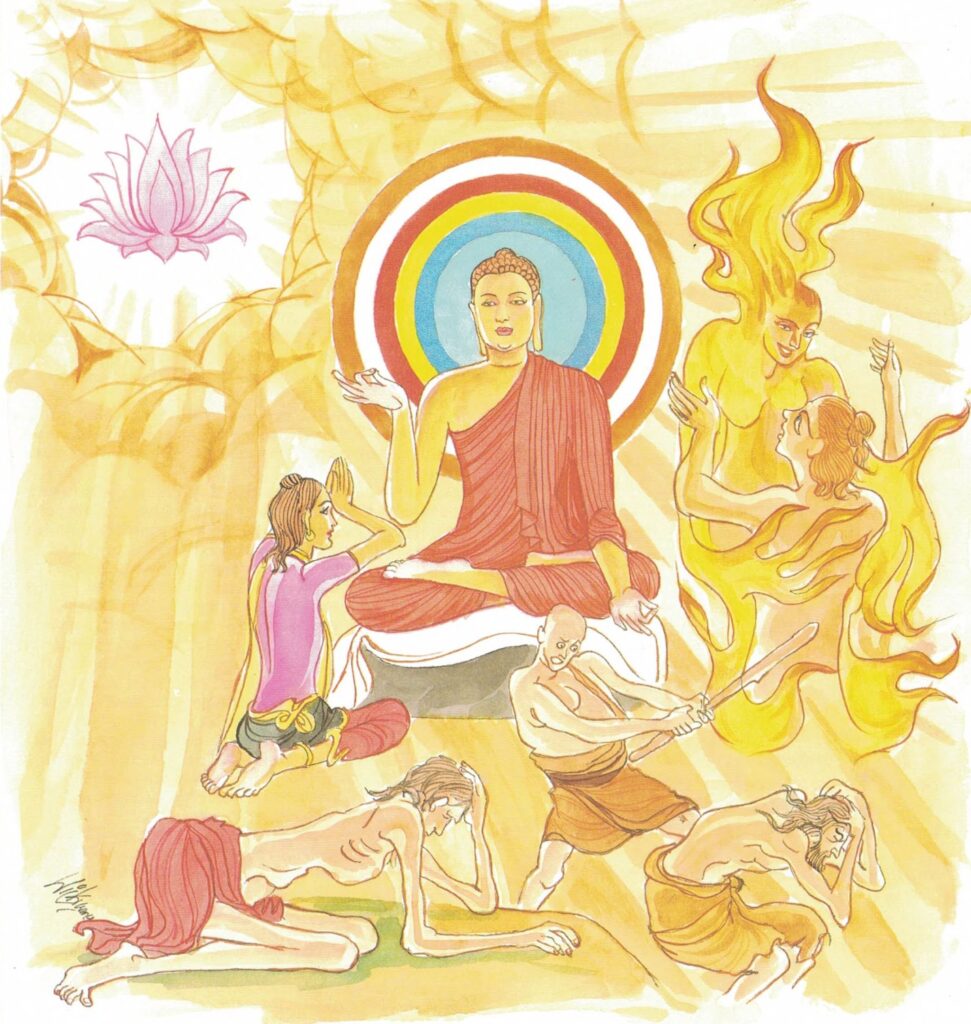Pali text, illustration and English translation of Dhammapada verse 202:
natthi rāgasamo aggi natthi dosasamo kali |
natthi khandhasamā dukkhā natthi santiparaṃ sukhaṃ || 202 ||
202. There’s no fire like lust, no evil like aversion, no dukkha like the aggregates, no higher bliss than Peace.

The Story of a Young Bride
While residing at the Jetavana Monastery, the Buddha spoke this verse at the house of a lay-disciple, with reference to a young bride.
On the day a young woman was to be wedded to a young man, the parents of the bride invited the Buddha and eighty of his disciples for alms-food. Seeing the girl as she moved about the house helping with the offering of alms-food, the bridegroom was very much excited, and he could hardly attend to the needs of the Buddha and the other monks. The Buddha knew exactly how the young bridegroom was feeling and also that time was ripe for both the bride and the bridegroom to attain sotāpatti fruition.
By his supernormal power, the Buddha willed that the bride would not be visible to the bridegroom. When the young man could no longer see the young woman, he could pay full attention to the Buddha, and his love and respect for the Buddha grew stronger in him. Then the Buddha said to the young man, “O young man, there is no fire like the fire of passion; there is no evil like anger and hatred; there is no ill like the burden of the five aggregates of existence (khandhās); there is no bliss like Nibbāna.” At the end of the discourse, both the bride and bridegroom attained sotāpatti fruition.
Explanatory Translation (Verse 202)
rāgasamo aggi natthi, dosasomo kali natthi
khandhasamā dukkhā natthi, natthi santiparaṃ sukhaṃ
rāgasamo [rāgasama]: like lust; aggi natthi: (there is) no fire; dosasamo [dosasama]: like anger; kali natthi: (there is) no crime; khandhasamā: like physical being; dukkhā natthi: (there is) no pain; santiparaṃ [santipara]: higher than peace of mind; sukhaṃ natthi: there is no happiness
There is no fire like passion. There is no crime like anger. There is no pain like the personalized aggregate of phenomena. There is no higher happiness than the supreme peace.
Commentary and exegetical material (Verse 202)
khandhāsamādukkhā natthi: no pain like physical being. The five groups of existence or groups of clinging (upādānakkhandha); alternative renderings: aggregates, categories of clinging’s objects.
These are the five aspects in which the Buddha has summed up all the physical and mental phenomena of existence, and which appear to the ignorant man as his ego, or personality, to wit:
- the corporeality group (rūpakkhandha);
- the feeling (vedanā);
- the perception (saññā);
- the mental-formation (samkhāra);
- the consciousness-group (viññānakhandha).
“Whatever there exists of corporeal things, whether past, present or future, one’s own or external, gross or subtle, lofty or low, far or near, all that belongs to the corporeality group. Whatever there exists of feeling–of perception–of mental formations–of consciousness–all that belongs to the conscious-group”
Another division is that into the two groups: mind and corporeality (nāma-rūpa), whilst in Dhammasangani all the phenomena are treated by way of three groups. What is called individual existence is, in reality, nothing but a mere process of those mental and physical phenomena, a process that since time immemorial has been going on, and that also after death will still continue for unthinkably long periods of time. These five groups, however, neither singly nor collectively constitute any self-dependent real ego-entity, or personality (atta), nor is there to be found any such entity apart from them.
Hence the belief in such an ego-entity or personality, as real in the ultimate sense, proves a mere illusion.
When all constituent parts are there,
The designation ‘cart’ is used;
Just so, where the five groups exist,
of living being do we speak.
The fact ought to be emphasized here that these five groups, correctly speaking, merely form an abstract classification by the Buddha, but that they as such, i.e., as just these five complete groups, have no real existence, since only single representatives of these groups, mostly variable, can arise with any state of consciousness. For example, with one and the same unit of consciousness only one single kind of feeling, say joy or sorrow, can be associated, and never more than one. Similarly, two different perceptions cannot arise at the same moment. Also of the various kinds of sense-cognition or consciousness, only one of them can be present at a time, for example, seeing, hearing or inner consciousness. Of the fifty mental formations, however, a smaller or larger number are always associated with every state of consciousness.
Some writers on Buddhism who have not understood that the five khandhās are just classificatory groupings, have conceived them as compact entities (heaps, bundles), while actually, as stated above, the Groups never exist as such, as they never occur in a simultaneous totality of all their constituents. Also, those single constituents of a group which are present in any given body-and-mind process, are of an evanescent nature, and so also their varying combinations. Feeling, perception and mental formations are only different aspects and functions of a single unit of consciousness. They are to consciousness what redness, softness, and sweetness, are to an apple and have as little separate existence as those qualities.